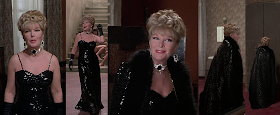Luchino Visconti's
The Damned (aka
La caduta degli dei in its native Italy) centred on a family of perverted industrialists who manipulate one another as they curry favour with Hitler's new regime. Costume designer Piero Tosi had to recreate 1930s German upper class fashion, but not copy the glitz and glamour associated with American movie stars of the era.In an
interview with Variety, Tosi recounted;
'
My goal was to rediscover, through movie characters’ look, the refined and sober style of the German world in that specific historical moment, different from glamor and the glossy and sexy image 1930s Hollywood America promoted through its movies'. Tosi also had the problem of using fabrics best-suited for the period, to make the period setting believable, '
It was the late ’60s and fashion at that time proposed rigid fabrics to support the geometric and linear clothing styles. For soft and slippery lines typical of the early 1930s, I needed soft and drooping materials like crêpe and silk cadì. I had to use fur covers found in an old warehouse.'
The costumes were constructed at Tirelli Costumi, where Tosi fabricated the costumes he designed for many of Visconti's films. Naturally, sets of 1930s menswear were made for the male main players such as Dirk Bogarde and Helmut Berger, as well as clothes custom-made for the film's assorted child actors.
Naturally the extras' costumes would have been vintage clothing from wardrobe stock. Presumably the SA 'Brownshirt' uniforms, as well as the principal leads' SS uniforms, were custom-made for the film, with all other Nazi-era German uniforms coming from wardrobe stock for WWII films.
However, for this article we are mostly going to focus on the women's wear. Most of the film's dresses were designed for Ingrid Thulin as Sophie von Essenbeck, the family's resident femme fatale; Thulin's first outfit is a black dress worn with a dark blue sequined bolera jacket with raised shoulders, and glittery strips on the collar.
Thulin's second dress doesn't get seen fully; a slinky black dress with sparkling lining around the chest and back.
For when Sophie discusses with the SS, Thulin wears an asymmetrically patterned silver and dark brown dress, with silver lining inside the sleeves; the look is completed with a translucent brown wide-brimmed hat.
The dinner scene near the film's finale has Thulin wearing another black dress with silver ornamentation around the cuffs, with holes cut around the chest - the cuffs are detailed with small gems, some of which can only be seen depending on Thulin's posture in the shot.
One dress made for Thulin that only gets very little screentime in the final film is this black dress with a large ruffled collar, with a black flower fixed to it as well.
On that note, Thulin wears several nightgowns throughout the film; a silvery nightdress and frilly lilac top, a peach-coloured robe with furred cuffs, and my personal favorite, a kimono-style gown made of a patterned fabric with pink lining.
Thulin's last dress is similar in design to her earlier silver and brown dress, being pale pink and grey in its colour scheme, with the grey panelling asymmetrical in design. The dress is worn with a cloche hat and veil.
Tosi also had to dress Charlotte Rampling as Elizabeth Thallmann, another relative of the family who finds herself embroiled in its sinister machinations, In contrast to Thulin's costumes mostly being designed with dark colours, Rampling's utilize lighter colours, highlighting her relative innocence in comparison. Rampling first appears sporting a cream lace dress with a flower on her shoulder.
Rampling also wears this sleek silvery nightdress when the SS arrives to arrest her husband, notice the curved panelling around the waist.
Rampling's other costumes in the film are more on the formal side, such as the white and brown top with an asymmetrically-cut collar, and the coat with strips of panelling around the lapels. Shame you can't see the dress underneath the coat, though!
Florinda Bolkan stars as Olga, girlfriend to Helmut Berger's Martin von Essenbeck, the sociopathic heir to the family's fortune; Bolkan first appears wearing a tan suit with curved pockets, and is worn with a wide brimmed hat and brown, white and orange patterned scarf.
Bolkan is also briefly seen wearing an orange-red nightgown with pink furred lining around the lapels and cuffs - it doesn't get good screntime due to Bolkan either sitting in bed or moving fast when wearing it.
When Olga is finally a part of the Essenbeck family, a silvery cocktail dress with glittery lining around the chest and back, worn with silver high-heels.
Lastly, is of course the drag costume sported by Helmut Berger during Martin's drag routine as Marlene Dietrich at the film's start - with glittery lining around the chest and over the front, topped off with a silver top hat and feather boa!
















































